

| This area of this site shows ALCATRAZ, a small island in the San Francisco bay. The island was discovered by the Spanish (Juan de Ayala) in 1775 and covers less than 19 acres. The name is derived from the Spanish word "Alcatraces", meaning "Pelicans". With the California gold rush, the island was home to a lighthouse that was erected in 1853. After that, the US army sought the island for protection of the San Francisco bay. Later on, from 1907 to 1934, Alcatraz was a location for a military prison until the US department of Justice took it over in 1934. From 1934 to March of 1963, the installation was a federal prison, housing some of the most notirious criminals, such as Al Capone and Robers Stroud (aka "Birdman"). The prison closed for good in 1963, with Frank Weatherman as the last inmate to leave, and has since been abandoned. In 1969, a group of American Indians tried to claim the island, but were unsucessful. Since then, Alcatraz became a landmark and part of the United States system of National Parks. With its iconic steel and concrete slowly corroding to the salty fog and winds of the bay area, Alcatraz remains an island frozen in time, while becoming a haven for wildlife, movie-makers, and tourists alike. In this section, see Alcatraz as a place of wonder and history as you step back in time to one of the most inhospitable places to be incarcerated in what was said to be "escape proof" - Welcome to "The Rock"! ... Note - This page may take a while to load on some SLOWER connections! |

 Video Clips Coming Soon!
Video Clips Coming Soon!

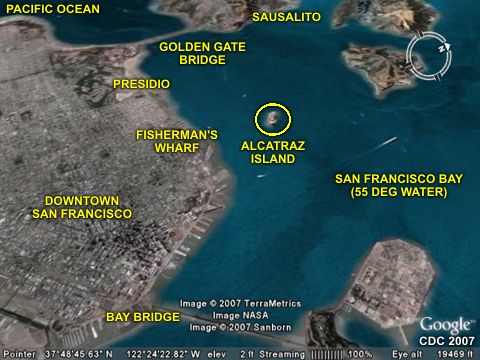
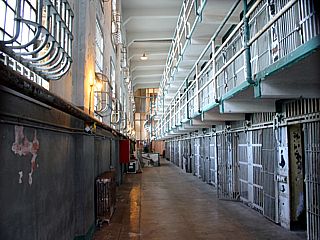
|
Here is the first section of the Alcatraz prison, cell block A. Used only for a short time during Alcatraz's tenure as a prison, it housed some of its first inmates. Later on, during prison expansion, other cell blocks, mainly C and D, became the main residences for prisoners here, after which, cell block A was removed from service, and used mainly for storage. |
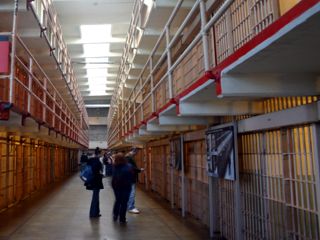
|
Here is a view of the main so-called CD "avenue" between prison blocks C and D. The prison blocks, containing the cells, were located on each side of these 'avenues", connected by "cutoffs", and were a three tier (3 story) design, which was state-of-the-art for it's time during the 1950's to 1960's. |
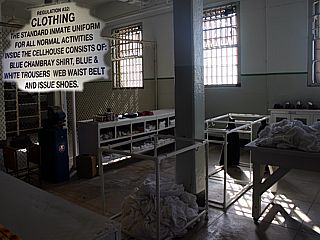
|
The grim process of your first day at this place occurred here, where you were issued your clothing, a prison uniform with an identification number for each inmate. From here, new prisoners were escorted to their cells, which often was a life-time commitment. If you were sent to Alcatraz, you would spend the REST OF YOUR LIFE at Alcatraz! |
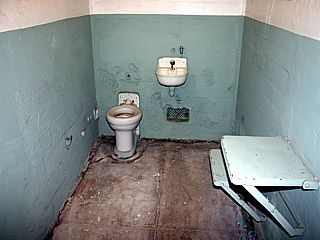
|
This is it ... This was your "accommodations" for the rest of your life at Alcatraz. Each cell was no more than 45 square feet (5 feet wide be 9) feet in length, which is about 1/4 of the size of the average bedroom. You were given a small bed (now shown in this picture), shelves (to the right) and on the far wall (not shown), a sink, and commode (toilet). Just the bare necessities to support your basic needs. Inmates were allowed a LIMITED number of toiletries and books in each cell. Anything extra, such as recreation, always had to be EARNED at Alcatraz. Imagine being the next inmate being escorted to his cell, as other inmates feciciously "cheered you on" as an informal welcome to their "world"! |
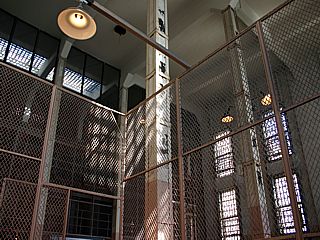
|
Any inmate lucky enough to EARN reading rights had access to this highly secure library. The books are no longer there, but the fencing, locks, and security infrastructure remains. |
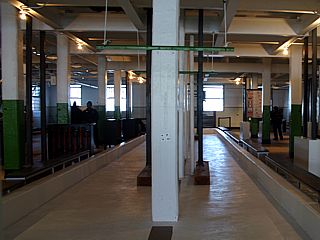
|
Here is a picture of the shower area of Alcatraz prison. The plumbing and shower heads have been removed, but the structure remains. This area used to be partitioned for privacy, but the partitions were removed so inmates can be watched by guards, and looks much the same way it does here (less the plumbing). |
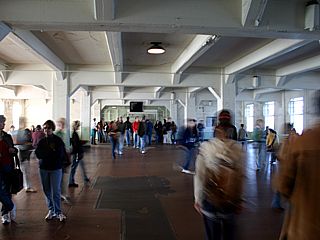
|
This is the main dining hall of the Alcatraz prison. The serving area is at the far end of the room, where the metal bars cover the kitchen entrance. This area was the most vulnerable area for riots and altercations, with the frightening possibility of volunteer prisoners frequently procuring knives and cutlery from the kitchen, and was heavily guarded. Above the serving area was a "whiteboard" showing the food being served. To the upper right sde of the picture is a tear-gas canister, used in the event a riot would erupt. |
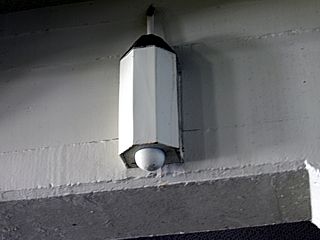
|
Here is a cloes-up of one of the tear gas dispensers located near the ceiling at the Alcatraz dining hall. In the case of a riot or violent altercation, a switch was "thrown" to activate the canisters. Tear gas wwould be dispensed into the dining hall and incapacitate the "rebels". This room got its slang name of the "gas chamber". Fortuntatly, these units were never used. |
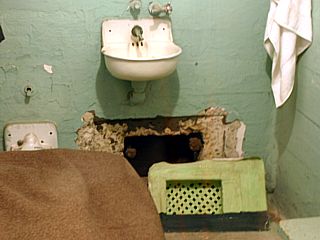
|
This is a picture of one of the prison cells where the June 1962 escape attempt (and possible success) was accomplished. Three inmates, Clarence Anglin, John Anglin, and Frank Morris, literally sawed (using spoons and eating utensils as tools) through the ventilation system of the cell block (as shown in this picture), and entered the utility tunnel behind the cells. They managed to climb to the roof, evade security, and disappear into the San Francisco Bay. To this day, there where abouts are still unknown. Some presume they drowned, others assume they fled to Mexico. The vent hole, and ease of carving it larger to fit a human through and into the utility corridor, was a MAJOR security flaw of Alcatraz. |
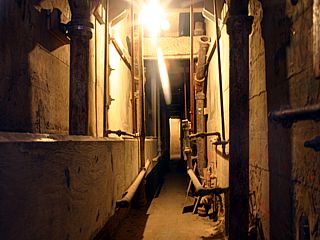
|
Here is a picture of the utility corridor that was behind all prison cells at Alcatraz. It is this un-patrolled "hollow space" that was to be a major flaw in the security of Alcatraz. Three inmates, Clarence Anglin, John Anglin, and Frank Morris, were beleived to use this method as one of the most incredible prison escapes of all times. |
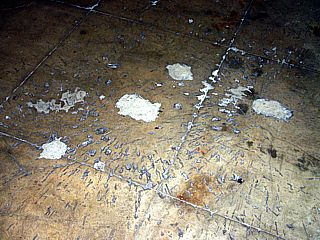
|
Craters and shrapnel marks scar the floor between cell blocks C and D at Alcatraz from the detonation of granades on the floor during the 1946 prison break. The craters shown here were filled in with cement, but one can visulize the effects of the explosion and flesh-cutting shrapnel that were flung out from each detonation, leaving their marks in the cement. |
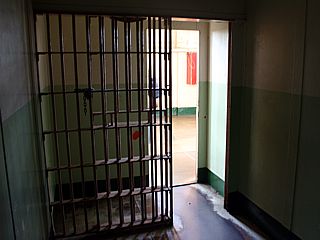
|
Really un-ruly prisoners were committed to solitary confinement. In this picture, we see a view out from a solitary confinement cell. The purpose of this type of punishment was sensual ISOLATION, where you were sealed in this cell, devoid of any light and reference to the outside world. One prisoner kept in solitary popped off a button from his garment and "played a game" to find that button simply to keep himself sane during solitary. |

|
Here is a picture of damaged / peeling paint on the concrete walls of the dining hall of the Alcatraz prison. Just the number of coats of paint tells you how many times this wall has been painted - Count them!. |
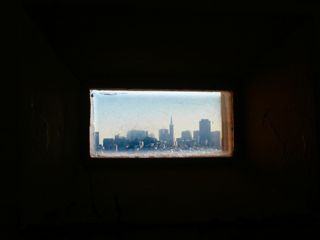
|
One of the worst experiences for prisoners unlucky enough to be sentenced at Alcatraz was the reality of how close one was to "freedom". Though this little "slit" in the thick walls of Alcatraz prison, inmates could view downtown San Francisco, only a mile and a half away. On Christmas and New Years, music and celebration could be heard through these openings in the walls. Freedom was so close, yet so far, driving many inmates more insane and stir-crazy. |

|
The slang name of Alcatraz island is "The Rock", and for very obvious reasons, as basically, that's what it is, a "rock"! Approaching Alcatraz island via ferry from the southeast, the view apepars as a "rock" with the all-important lighthouse atop. The docking area is to the right of the island in this picture. On this navigational hazard is a full community and self-sufficient collaberation of United States punishment to the extreme, all surrounded by the bone-chilling and treacherous waters of the North Pacific. Imagine what a new inmate would have been thinking about seeing this SAME view, approaching the island via US Department of Corrections prison transport, shackled in chains and surrounded by guards, and on a crisp and clear day in the San Francisco Bay! |
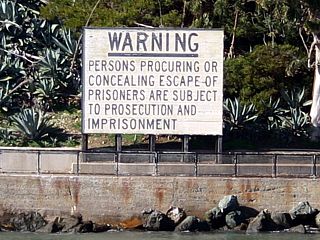
|
This is a warning sign that appears on the southern tip of Alcatraz. It's a warning against anyone helping in escape attempts from the island. |
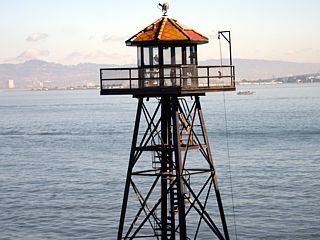
|
This is a guard tower near the main docking area on the southeastern side of Alcatraz island. Obviously, with this side of the island being "closest" to "freedom", it was also the most heavily guarded. |
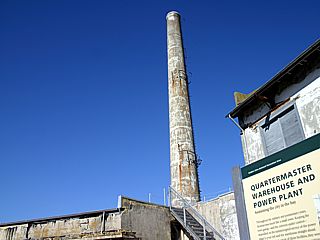
|
Alcatraz was designed to be a self-contained prison colony outside of supplies brought from the nearby city. Electricity was provided by this power plant pictured here, and the quartermaster's warehouse housed supplies, tools, and fuel. |
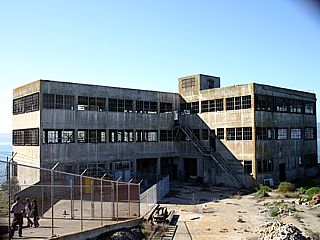
|
This building was one of the industrial operations buildings where heavily guarded prisoners were given manual labor jobs at Alcatraz. Privileges at Alcatraz had to be WORKED FOR, nothing was free. These buildings had machine shops, laundry facitities, and also served for food preperation. |
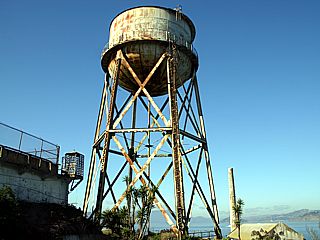
|
The original water tower at Alcatraz is a landmark (besides the lighthouse) and is still standing. To the left is the recreation area (note the heavily barred guard post). |
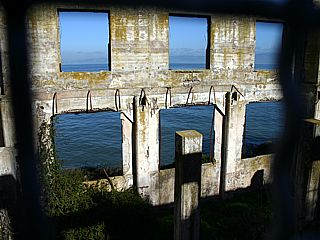
|
Here is a picture, looking through fencing, at he main social hall for workers of the Alcatraz prison. Many events with resident workers took place at this building, which even contained a small bowling alley. After a fire detroyed the building, only the concrete frame remains. |
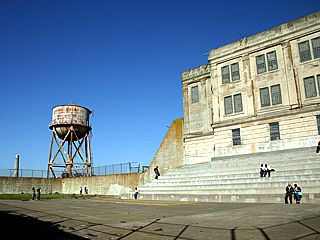
|
Prisoners at Alcatraz were entitled to outdoor recreation privileges if they were well-behaved. In this picture, the recreation area is shown, where inmates played bridge, basketball, and lifted weights among other activities. This area was also the most likely area for a prisoner to prisoner confrontation, such as stabbings. Guards watched over this area from heavily barred booths at each corner of the yard atop the walls. |
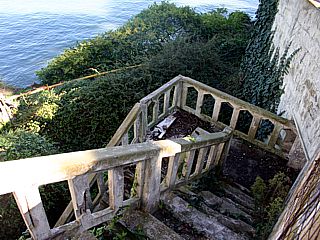
|
A staircase near the power plant and warehouse of the Alcatraz prison complex appears to stand still in time, slowly eroding from the effects of wind, salt, and fog. Plant life, much of which brought to the island for landscaping and erosion control, has taken foothold in the absence of man. |
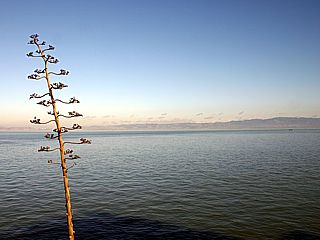
|
Alcatraz is not an ugly place, as it being home to a prison complex appears to make it appear to be. it is a place of serene beauty, wildlife diversity, and some of the most amazing views anyone living in the United States can appreciate. In this picture, any prisoner lucky enough to be near a small slit or window at Alcatraz may be treated to a view like this on a clear day! |
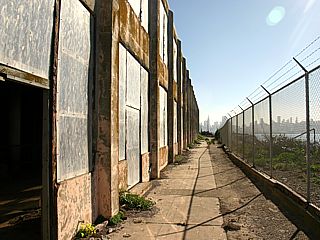
|
Here is a picture of the frontage of one of the industrial buildings. Both the building and barbed-wire fence to its right in this picture are slowly corroding in the salt air of the San Francisco bay as downtown San Francisco, in the backtround, continues to expand. |
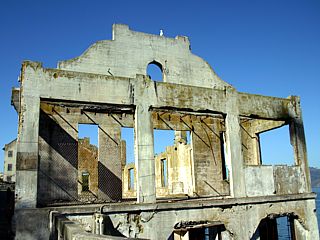
|
Alcatraz island was a navigational hazard to any shipping traffic into and out of the San Francisco bay. This lighthouse, the highest object on Alcatraz island, was a must to guide maritime traffic safely past it. The lighthouse is the second of two erected on the island, and is also equipped with a fog horn as well. It is still fully functional and guides maritime traffic past the island today. |
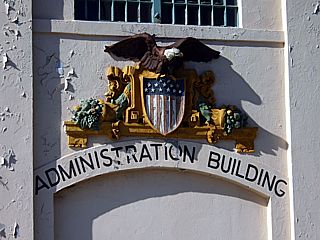
|
The main brain-center of Alcatraz was the administration building. This is where the wardens, operations, accountants, and legal apparatus all worked in order to run the prison. this area also contained a vault, prison control facility, and armory as well. On the main entrance, the proud ensignia of the United States still stands amidst peeling paint and the test of time since 1963. |
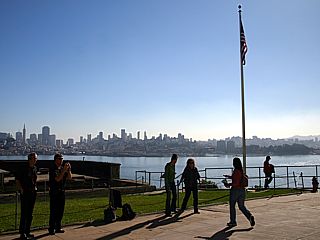
|
In front of the administration building at Alcatraz, workers can step outside on a nice day and take in the spectacular view of the San Francisco bay and downtown just a mile and a half away. This view is just to the right of the lighthouse, looking south and southeast. Inmates, just feet away, could only dream of such freedom. |
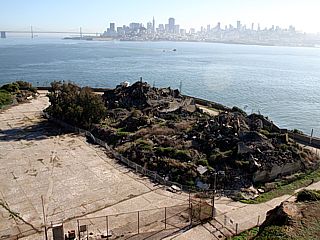
|
The southern and southeastern tip of Alcatraz island is also where housing for many prison workers and their families was located. In this picture, along the "parade area" of the island near the lighthouse and down one level, and with a spectaculr view of the San Francisco skyline and the Bay Bridge in the background, the remains of such a home can be seen in a pile of rubble. |
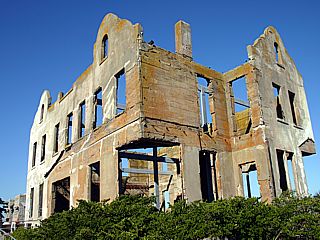
|
Here is a picture of one of the housing complexes for prison workers / administrative staff still standing on the southeastern tip of Alcatraz island. In this building, the finest of all homes for workers on the island, the wardens of the prison resided during their tenures. These buildings succombed to the effects of erosion, valdalism, and fire over the years. |
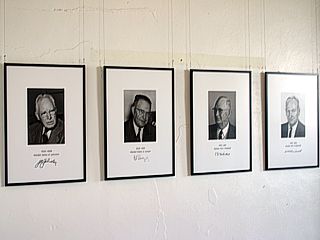
|
Four wardens ran the Alcatraz prison from the periods of 1934 to 1963. Their pictures are shown here on the wall in the administration building. From left to right is James Johnston, Edwin Slope, Paul Madigan, and Olin Blackwell. These men took a no-excuse approach towards prisoners, and even overlooked executions while keeping a stern and un-forgiving demeanour. |
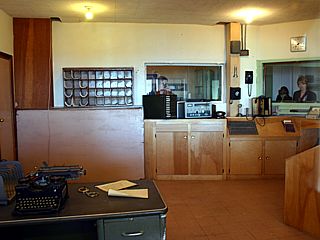
|
Here is a view of the control room in the administrative building at the Alcatraz prison. Not much compared to todays technology, but this was all you had, and state-of-the-art for the 1950's era. |
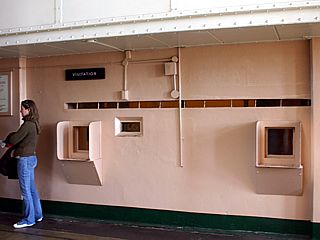
|
Visitation rights were also a privilege, and needed to be earned at the Alcatraz penitentiary. This is where friends, family members, and ex-co-workers viaited inmates during their limited times when they were able to have such visitors. Interactment and conversation ocurred through bullet-proof glass between prisoner and visitor. |
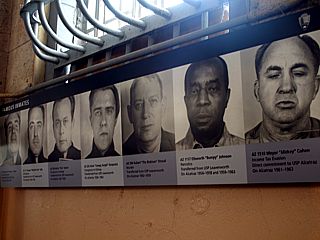
|
The US penitentiary at Alcatraz housed some of the most infamous and violent criminals for it's time. Among these pictures, we see the familiar faces of Al Capone, Meyer Cohen, and murderer Robert Stroud (aka "The Birdman"), to name a few! |
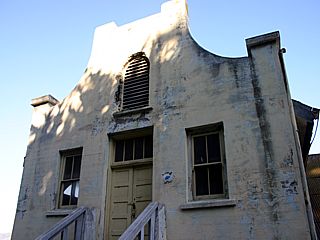
|
Like all other FREE civilians, workers at Alcatraz were entitled to any activity on Alcatraz island as those on the mainland would be. This building is a chapel / church, where religeous services for workers were provided. Adjacent to that was a small store, social hall, and other provisions to provide to the resident workers on the island. |

|
This is the main social hall for workers of the Alcatraz prison. Christmas and new years parties, birthdays, and other events were held here. The building suffered a fire and only its concrete frame remains. A small bowling alley and gym also were provided in the social hall. |
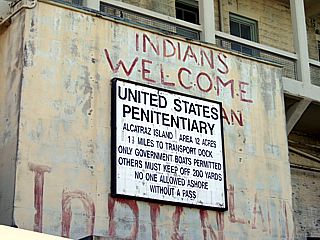
|
Back in 1969, a group of Native American Indians attempted to take control and ownership of the island of Alcatraz. In this picture, a sign was altered to include the word "Indians" near the dock and entrance to the prison facility. |
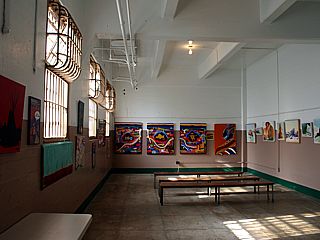
|
Here is another picture of one of the rooms adjacent to the dining hall area of the Alcatraz prison. The un-mistakable Native American artwork can be seen hanging on the walls of the room. This was due to the fact that in in 1969, Native American Indians attempted to take control and ownership of the island. |
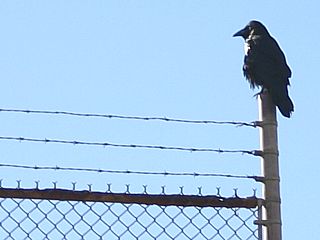
|
Today, only wildlife permanently inhabits the island of Alcatraz, like this heron sitting atop a rusting fence post near the recreation yard of the prison. |
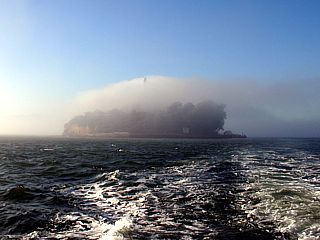
|
The island of Alcatraz fades into an incoming fog bank during the ferry ride back to Pier 33 at San Francisco. |
HTML File "alcatraz.htm" - Developed By Chris Collura
To Return To The HOME Page Of This Site Click The "INDEX.HTM" Link Here!